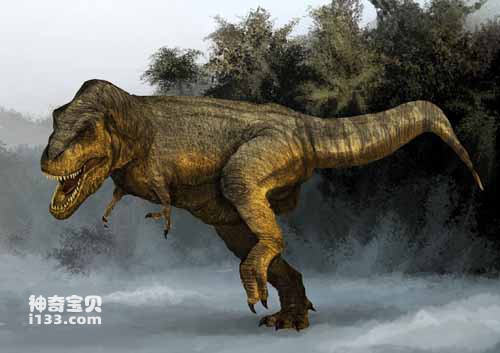Tyrannosaurus Rex, also known as Tyrannosaurus rex, is the largest land carnivore in history. It weighs about 5 to 7 tons and may reach 15 meters in length. Such a behemoth seems to be specially designed to attack other dinosaurs. Its head is long and narrow, with well-developed cheek muscles. The 1.2-meter-long mandible is very large. The head is 1.5 meters long, and the 10.2-cm eye sockets contain eyeballs with a diameter of 7.6 cm. Its neck is short and thick, and its body is strong. Its hind limbs are strong and thick. The tail is not too long and can be straightened back to balance the body; the mouth is wide open and has sharp teeth about 23 to 33 centimeters long. However, the forelimbs are disproportionately small. It is only 1 meter long and has only two larger ones. Weak fingers.
Although more people know it as Tyrannosaurus rex, we call it Tyrannosaurus rex. We have two reasons for doing this. First, for some animals in the series, there is enough evidence to identify the genus, but not the species within the genus. Second, it makes the name less confusing. While everyone is familiar with the name Tyrannosaurus rex, it would be inappropriate to give all animals their full names.
The food supplied to Tyrannosaurus is mainly ceratopsians and hadrosaurs. We have confirmed this food hypothesis. Ericson of the Rocky Mountain Museum in Montana discovered that the hip bone of a Triceratops was covered with tooth marks. Apparently these large carnivorous dinosaurs fed on Triceratops. To find out what kind of carnivorous dinosaur it was, Ericsson filled one of the deep bite marks with dental putty, resulting in a cast that was apparently identical to a Tyrannosaurus rex's teeth. This result also shows how they actually eat. They do not carefully peel the meat from the bones, but bite hard through the meat and bones, and then tear off large pieces of meat.
Similar to living large carnivorous cats, fighting between individuals is an obvious characteristic of Tyrannosaurus. Their skulls and bones have more or less horrific wounds and bite marks. And there are many examples that show this wasn't caused by their bodies being turned over after death, we have evidence of healing (such as the growth of new bones) that proves the wounds were inflicted while the dinosaurs were still alive.
In fact, these tooth marks also reveal another key element of Tyrannosaurus's behavioral characteristics - their heads were their primary weapons. If we compare the body shape of Tyrannosaurus with other carnivorous dinosaurs, we will obviously find that Tyrannosaurus's arms are much shorter than other dinosaurs, its teeth are much larger than other dinosaurs, and its lower jaw is stronger. Because the Tyrannosaurus's arms were so short, its arms could only be used as grappling hooks when it bit other dinosaurs. There is a debate in the paleontological community about whether Tyrannosaurus was actually an active predator. The famous paleontologist Holm was opposed to this. He believed that Tyrannosaurus was just a carrion-eating dinosaur. However, we have learned from a lot of materials that due to the conditions of Tyrannosaurus, it is by no means just a carrion-eating dinosaur. Of course, like many carnivores today, it sometimes eats carrion.

Chinese name: Tyrannosaurus Rex
Latin name: Tyrannosaurus
Age of survival: Late Cretaceous
Fossil origin: Alberta, Canada, New Mexico, Montana, Colorado, Wyoming, etc.
Physical characteristics: 12 to 15 meters long
Diet: Carnivorous
Species: Theropod
Definition: Brutal lizard
animal tags: Tyrannosaurus
We created this article in conjunction with AI technology, then made sure it was fact-checked and edited by a Animals Top editor.